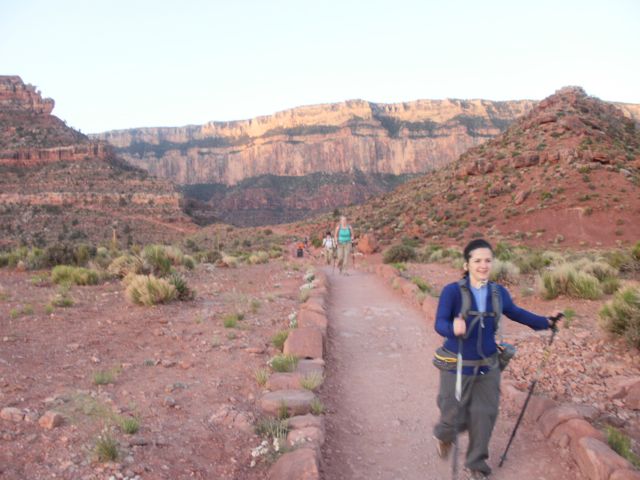Water, Sweat and Low Humidity
Low humidity means your sweat will evaporate very, very fast. In the desert, you will not realize you are sweating. This is confusing because you may think it’s awesome, you are hiking hard for hours and you not even breaking a sweat. Not true and this is a big flipping deal: you are probably losing anywhere from 1 to 2 liters of water through undetectable sweat each hour.
Constant hydration and electrolyte replacement is critical. If you wait to drink until you feel thirsty you have messed up Big Time and you are already in the early stages of dehydration. Drink all day long, even though you are not thirsty. Katie, Shelly, Whig’um, Amy and I made it a habit on past hikes of reminding each other to drink while we are hiking. Whether you yell “Drink”, or “Party Time”, or “It’s 5 o’clock Somewhere”, just be aware that you should be sipping and drinking constantly and your hiking partners should be drinking too. If they aren’t drinking and pee’ing, your job is to make sure that they do. Their life, and yours, are at risk.
I take packets of restaurant salt with me on the hike in addition to my electrolytes. Slamming a packet of salt will boost blood pressure to the head. Last year when Milo was extremely tired and getting confused we made him rest, drink electrolytes, and slam salt. After 4 hours he literally “woke up” (I’m not sure what else to call it).
We fight the sun and the heat in several ways. First by covering up your arms and legs with light colored and loose clothing, hat, and bandanas to deflect the heat. Secondly, we dunk our shirts, hat, and bandanas in any water sources we find or have, and then we put it back on soaking wet because it will cool us off. Third and most importantly, by proper hydration and electrolyte replacement. Fourth, by reading long messages like this one so you walk into the Canyon educated and prepared for what may occur.
Dehydration leads to Heat Exhaustion (extreme fatigue, headaches, weakness, breathlessness, dizziness, nausea, vomiting, fainting, low blood pressure, weak/rapid heart rate). If you have never read about it, you should look it up and spend a little time doing your own research so you understand the signs and treatments and know more than my simple explanation. I have no medical training but I understand it to mean that your cardiovascular system can’t meet your body’s needs. It can be life threatening.
Stop and rest in a cool place (shade), get into the cold water if you are near a creek, prop your feet up so they are higher than your head (to avoid shock), and drink salt water. If needed, wait until dark when it is cooler and you are rested to continue hiking. If untreated, you risk going into Heat Stroke.
Heat Stroke is life threatening. Common symptoms are confusion, you stop sweating, high blood pressure, rapid pulse and breathing, and eventually unconsciousness. If untreated it can leads to a coma then death. The fatal mistake of many hikers is hiking alone and getting into a heat illness situation where they can’t think clearly, can’t make good decisions, and they can’t treat their own heat related illness symptoms.
You have been training for months to be in top physical shape, trying out your gear and equipment, drinking your electrolyte drinks so you don’t end up with a flavor you can’t stand, and reading all my long doom and gloom e-mails to prepare for the adventure of a lifetime. All of this preparation and information is necessary so that we can all HIKE SMART AND HIKE SAFE.
© 2013.  Jean N.  All Rights Reserved.
